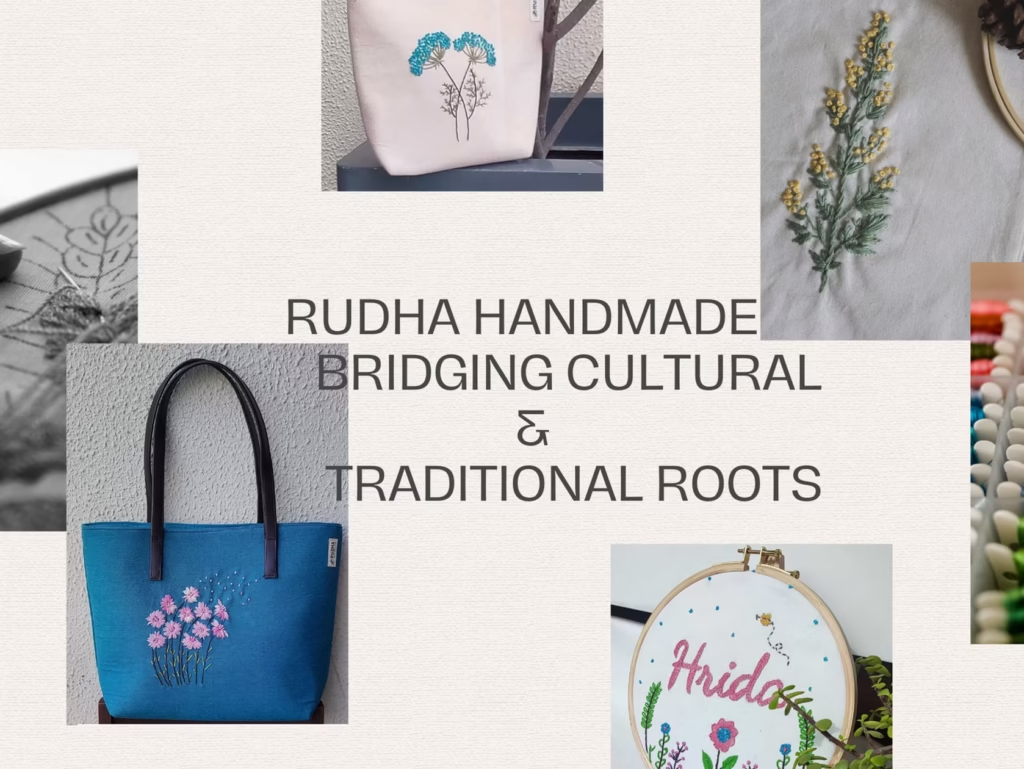Rudha Handmade: Weaving Threads of Tradition and Culture. Our artisanal creations are more than just handcrafted treasures; they’re a bridge between cultural legacies and contemporary elegance. Each stitch tells a story, preserving time-honored techniques passed down through generations.
With Rudha Handmade, we celebrate the rich tapestry of cultural heritage, infusing modern designs with traditional craftsmanship. Our pieces are more than accessories; they’re a connection to roots, a nod to heritage, and a celebration of the enduring beauty found in the art of hand embroidery.
Explore the intersection of tradition and innovation with Rudha Handmade’s meticulously crafted wonders. Visit Store here www.rudha.in

The charm of hand embroidery lies in its unique qualities that set it apart from machine-produced items. Several factors contribute to the allure of hand embroidery and the higher cost associated with hand-embroidered items:
Artisanal Craftsmanship:
Hand embroidery is a labor-intensive craft that requires skill, precision, and creativity. The hands-on involvement of skilled artisans contributes to the uniqueness and individuality of each piece.
Personalization and Customization:
Hand embroidery allows for a high degree of personalization and customization. Artisans can adapt designs, stitches, and colors based on individual preferences, creating bespoke items that cater to specific tastes.
Time-Consuming Process:
The intricate nature of hand embroidery makes the process time-consuming. Artisans invest hours, if not days, into creating a single piece, resulting in a product that reflects meticulous attention to detail.
Quality of Materials:
Hand-embroidered items often use high-quality materials, including fine fabrics and threads. The combination of premium materials and skilled craftsmanship contributes to the overall value and durability of the finished product.
Heritage and Tradition:
Hand embroidery often carries cultural and historical significance, with many traditional techniques passed down through generations. The preservation of these techniques adds a layer of cultural richness and heritage to hand-embroidered items.
Limited Production:
Due to the manual nature of hand embroidery, production quantities are limited. This exclusivity and scarcity can contribute to the perceived value of hand-embroidered items.
Artistic Expression:
Hand embroidery allows artisans to express their artistic flair and creativity. Each stitch is a form of self-expression, and the final piece reflects the unique style and skill of the individual artisan.
While hand-embroidered items may be more expensive, the cost is reflective of the craftsmanship, time, skill, and individuality invested in each piece. Consumers often value the charm, uniqueness, and cultural significance associated with hand embroidery, making it a sought-after and premium option in the world of textile arts.
Choosing handmade items over mass-produced alternatives often stems from a range of preferences and values that individuals hold. Here are several reasons why people opt for handmade items:
Unique and Individualized:
Handmade items are often one-of-a-kind, reflecting the artisan’s style and craftsmanship. This uniqueness appeals to those who appreciate owning something distinctive.
Artistic Expression:
Handmade items allow artisans to express their creativity and artistic vision. Consumers may value the personal touch and artistic flair that comes with handmade creations.
Supporting Artisans and Local Businesses:
Opting for handmade items supports local artisans and small businesses. Consumers may prefer contributing to the livelihoods of individual craftspeople rather than large, impersonal corporations.
Quality Craftsmanship:
Handmade items often exhibit a higher level of craftsmanship. Artisans invest time and attention to detail, resulting in products that are well-made and durable.
Ethical and Sustainable Practices:
Handmade items are often associated with ethical and sustainable practices. Consumers who prioritize environmentally friendly products may choose handmade items to support a more sustainable and eco-conscious approach to production.
Cultural and Traditional Significance:
Handmade items often carry cultural or traditional significance. Choosing handmade products can be a way of preserving and appreciating traditional craftsmanship and techniques.
Connection to the Maker:
Knowing the person behind the product can create a sense of connection and authenticity. Consumers may appreciate the transparency and direct relationship with the artisan.
Customization:
Handmade items frequently offer customization options. Consumers can request personalized details, ensuring that the final product meets their specific preferences.
Storytelling and Narrative:
Handmade items often come with a story. Knowing the process and the hands that crafted the item can add a layer of meaning and narrative that may be absent from mass-produced goods.
Value for Handcrafting Skills:
Choosing handmade items is a recognition of the value placed on traditional handcrafting skills. It reflects an appreciation for the time, effort, and expertise invested in creating each piece.
In summary, the decision to opt for handmade items is often driven by a combination of factors, including a desire for uniqueness, support for local artisans, appreciation of craftsmanship, ethical considerations, and a connection to the cultural and traditional roots of the products.

At Rudhaa, we create more than just products — we craft experiences filled with purpose, passion, and handmade charm.
Copyright © 2025 Rudhaa. All right reserved.